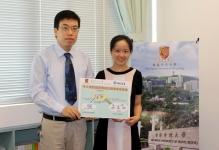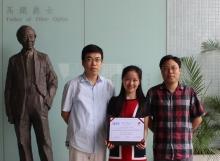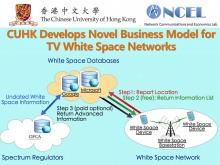The Network Communications and Economics Lab (NCEL) led by Prof. Jianwei Huang, Department of Information Engineering, The Chinese University of Hong Kong (CUHK), has recently proposed a novel information market model for utilizing idle TV white space spectrum, which can bring a significant profit to the white space database operator, while guaranteeing mobile users' high quality wireless communication service. This work won the Best Paper Award in IEEE WiOpt 2014 (http://www.wi-opt.org), a single-track leading wireless conference focusing on modeling and optimization of wireless networks. In most places, radio spectrum is allocated by strict licensing to different wireless applications. Driven by the explosive growth in smartphones and bandwidth-hunger applications, radio spectrum is becoming an increasingly scarce resource. It is becoming increasingly challenging for the current 3G/4G cellular network to fully satisfy the fast growing demands. Many countries have been trying to utilize the unused or under-utilized TV broadcast frequency channels (TV white space) to provide the so-called super Wi-Fi services. Comparing with today's traditional Wi-Fi technology, super Wi-Fi can extend the coverage to several to tens of kilometers. For example, a single super Wi-Fi base station with 30km coverage radius can cover an area of 2,000 CUHK campus. Regarding the transmission data rates, the current Wi-Fi technology can support a transmission rate of 5Mbps/MHz at a distance of 35 meters in an indoor environment. The super Wi-Fi can achieve the same indoor transmission rate at a distance of several hundreds. Moreover, due to the strong penetration capability of the super Wi-Fi technology, it can significantly improve communication qualities of smart meters and smart appliances, and facilitate large-scale deployments of new technologies such as M2M (machine to machine) and D2D (device to device) communications. Today, countries such as USA, UK, and Singapore have been very active in developing database-assisted TV white space network trials. There is also a sizable amount of TV white space in Hong Kong, although how it should be used is still under discussion. Recently, the local regulator, the Office of the Communications Authority (OFCA), has claimed that the government would auction off a third of the 3G spectrum currently held by city's incumbent 3G mobile network operators. This results in customers' concerns in the potential deterioration of mobile communication service quality. Exploring the use of TV white space is one of the most effective solutions for alleviating the tension between limited network capacity and fast growing customer demands. However, in contrast to the fast technology development of TV white space networking, the development of business models for this new network architecture is significantly lagging behind. Obviously, the lack of full understanding of such a business model will hamper the commercialization of TV white space network. Through the study of new business models of TV white space networks, Prof. Jianwei Huang and his team hope to increase the utilization of TV white space, provide new business opportunities to wireless service providers, and reduce the cost for the wireless consumers. The Business Model for TV White Space: Trade Information, Not Spectrum In most recently proposed business models for wireless spectrum, the unlicensed spectrum users need to purchase short-term usage rights from the licensed holders in a secondary spectrum market. However, TV white space is often defined as public goods, which do not have licensed owners and cannot be directly traded. In order to tackle this challenge, the CUHK research team proposed a new business model – the information market – to trade the network information related to TV white space channels instead of the channels themselves. Accordingly to the latest TV white space technology standards, an unlicensed spectrum user needs to inquire an authorized TV white space database regarding the available white space channels, and selects one channel for its communications. This is similar as today's mobile phones' process of searching for wireless networks. In the information market model proposed by Prof. Jianwei Huang and his team, the unlicensed users can also choose to purchase information from the spectrum database regarding the white space channels. Such information includes not only the basic information regarding the availabilities of channels, but also the advanced information regarding channel quality and interference level of each channel. With such information, the unlicensed spectrum user can choose a high quality white space channel for its communications, hence avoiding significant interferences from other mobile devices and maximizing the communication quality. Through the information market model proposed by the CUHK NCEL team, the mobile users are able to freely choose between the free basic service and the premium information service when utilizing the TV white space channels. The TV spectrum database operators are able to make revenue through selling the advanced information, hence achieving a win-win situation. Such an information market business model can be directly applied to the current TV white space technology framework, without requiring additional investment in hardware. About Network Communications and Economics Lab (NCEL) The Network Communications and Economics Lab (NCEL) was formed in 2007 by Prof. Jianwei Huang in the Department of Information Engineering, focusing on the interdisciplinary research among communications, networking, and economics. The NCEL team has published over 160 papers in top international journals and conferences, with a total citation of more than 4,100 times. The NCEL's research results have received 7 Best Papers Awards in international venues, including the 2011 IEEE Marconi Prize Paper Award in Wireless Communications from IEEE Communications Society and IEEE Signal Processing Society. Four papers from NCEL are among the ESI Highly Cited Papers in the field of Computer Science, which are the 1% top papers in terms of citations within the field according to Essential Science Indicators from Web of Science. The co-authors of this awarding winning work also include Ms. Yuan Luo and Dr. Lin Gao. Ms. Luo is a PhD student under the supervision of Prof. Jianwei Huang, and received the prestigious Hong Kong PhD Fellowship from Hong Kong Research Grant Council in 2011, with a monthly award of HKD20,000 for three years. Dr. Lin Gao is a Postdoc Research Fellow in CUHK, and received the Best Paper Awards from IEEE WiOpt in both 2014 and 2013. For more information, please see http://jianwei.ie.cuhk.edu.hk. |
|





